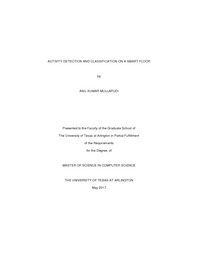
ATTENTION: The works hosted here are being migrated to a new repository that will consolidate resources, improve discoverability, and better show UTA's research impact on the global community. We will update authors as the migration progresses. Please see MavMatrix for more information.
Show simple item record
| dc.contributor.advisor | Manfred, Huber | |
| dc.creator | Mullapudi, Anil Kumar | |
| dc.date.accessioned | 2017-07-03T15:58:08Z | |
| dc.date.available | 2017-07-03T15:58:08Z | |
| dc.date.created | 2017-05 | |
| dc.date.issued | 2017-05-18 | |
| dc.date.submitted | May 2017 | |
| dc.identifier.uri | http://hdl.handle.net/10106/26835 | |
| dc.description.abstract | Detecting and analyzing human activities in the home has the potential to improve monitoring of the inhabitants' health especially for elderly people. There are many approaches to detect and categorize human activities that have been applied to data from several devices such as cameras and tactile sensors. However, use of these sensors is not feasible in many places due to security and privacy concerns or because of users who may not be able to attach sensor to their body. Some of these issues can be addressed using less intrusive sensors such as a smart floor. A smart floor setup allows to detect human temporal behaviors without any external sensors attached to users. However, use of such indirect, environmental sensors also changes the character and quality of the data available for activity recognition. In this thesis, an approach to activity detection and classification aimed at smart floor data is developed and evaluated. The approach developed here is applied to data obtained from a pressure-sensor based smart floor and activities of interest include standing, walking, and a miscellaneous class of movement.
The main aim this thesis is to detect and classify human activities from time series data which is collected from pressure sensors. No assumption is made here that the data has been segmented into activities and thus the algorithm must not only determine the type of activity but also has to identify the corresponding region within the data. The activities standing, walking, and other are identified in data obtained from pressure sensors which are mounted under the floor. Various features extracted from these sensors such as center of pressure, speed, and average pressure are used for the detection and classification. To identify activities, a Hidden Markov Model (HMM) is trained using a modified Baum-Welch algorithm that allows for semi-supervised training using a set of labeled activity data as well as a larger set of unlabeled pressure data in which activities have not been previously identified. The goal of being able to classify these activities is to allow for general behavior monitoring and, paired with anomaly detection approaches, to enhance the ability of the system to detect significant changes in behavior to help identify warning signs for health changes in elderly individuals. | |
| dc.format.mimetype | application/pdf | |
| dc.language.iso | en_US | |
| dc.subject | Hidden Markov Model | |
| dc.subject | Smart floor | |
| dc.subject | Baum-Welch algorithm | |
| dc.title | Activity Detection and Classification on a Smart Floor | |
| dc.type | Thesis | |
| dc.degree.department | Computer Science and Engineering | |
| dc.degree.name | Master of Science in Computer Science | |
| dc.date.updated | 2017-07-03T15:58:40Z | |
| thesis.degree.department | Computer Science and Engineering | |
| thesis.degree.grantor | The University of Texas at Arlington | |
| thesis.degree.level | Masters | |
| thesis.degree.name | Master of Science in Computer Science | |
| dc.type.material | text | |
Files in this item
- Name:
- MULLAPUDI-THESIS-2017.pdf
- Size:
- 1.348Mb
- Format:
- PDF
This item appears in the following Collection(s)
Show simple item record


